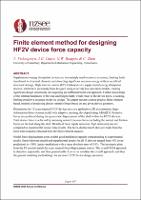| dc.description.abstract | Supplemental energy dissipation devices are increasingly used to protect structures, limiting loads transferred to structural elements and absorbing significant response energy without sacrificial structural damage. High force to volume (HF2V) dampers are supplemental energy dissipation devices, which have previously been designed using relatively low-precision models, creating significant design uncertainty and requiring an inefficient build-test approach. Further, knowledge of the internal mechanics of the lead and bulged shaft, which result in the device force, is lacking, limiting predictive accuracy in device design. This paper presents a more precise, finite-element based, method of predicting device resistive forces based on any given device geometry.
Dimensions for 15 experimental HF2V devices tests are applied to a 2D axisymmetric large-deformation finite element model with adaptive meshing, developed using ABAQUS. Resistive forces are produced during the quasi-static displacement of the shaft within the HF2V devices. Total device force is achieved by summing contact pressure forces including the normal and friction forces on the lead along the shaft. Results of these highly nonlinear, high strain analyses are compared to experimental device force results. The force-displacement plots are made from the force-time response obtained from the finite element analysis.
Model force-displacement plots exhibit good prediction capacity corresponding to experimental results. Errors between model and experimental results for all 15 devices ranged from -8% (over-prediction) to +20% (under-prediction) with a mean absolute error of 5.9%. The hysteresis plots from the FE models match the experimental force-displacement curves. The overall FEM approach is objective, repeatable, and thus generalisable. Low error validates the overall approach, and thus the general modeling methodology for accurate HF2V device design presented. | |

